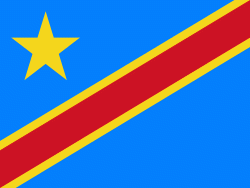Congolese franc
Fr
The Congolese franc is the currency of the Democratic Republic of the Congo. It is subdivided into 100 centimes. However, centimes no longer have a practical value and are no longer used. In April 2022, 2,000 francs was equivalent to US$1.Currency denominated in centimes and francs (Congolese frank) was first introduced in 1887 for use in the Congo Free State (1885-1908). After the Free State's annexation by Belgium, the currency continued in the Belgian Congo. The francs were equal in value to the Belgian franc. From 1916, the Congolese franc also circulated in Ruanda-Urundi (present day Rwanda and Burundi) and, from 1952, the currency was issued jointly in the names of the Belgian Congo and Ruanda-Urundi. After the independence of the Democratic Republic of the Congo in 1960, Ruanda-Urundi adopted its own franc, whilst, between 1960 and 1963, Katanga also issued a franc of its own.
The franc remained Congo's currency after independence until 1967, when the zaïre was introduced, at a rate of 1 zaïre = 1,000 francs.
Country
-
Democratic Republic of the Congo
The Democratic Republic of the Congo (DRC), also known as Congo-Kinshasa and formerly known as Zaire, is a country in Central Africa. By land area, the DRC is the second-largest country in Africa, after Algeria, and the 11th-largest in the world. With a population of around 112 million, the Democratic Republic of the Congo is the most populous officially Francophone country in the world. The national capital and largest city is Kinshasa, which is also the economic center. The country is bordered by the Republic of the Congo, Central African Republic, South Sudan, Uganda, Rwanda, Burundi, Tanzania (across Lake Tanganyika), Zambia, Angola, the Cabinda exclave of Angola and the South Atlantic Ocean.
Centered on the Congo Basin, the territory of the DRC was first inhabited by Central African foragers around 90,000 years ago and was reached by the Bantu expansion about 3,000 years ago. In the west, the Kingdom of Kongo ruled around the mouth of the Congo River from the 14th to 19th centuries. In the northeast, center and east, the kingdoms of Azande, Luba, and Lunda ruled from the 16th and 17th centuries to the 19th century. King Leopold II of Belgium formally acquired rights to the Congo territory in 1885 and declared the land his private property, naming it the Congo Free State. From 1885 to 1908, his colonial military forced the local population to produce rubber and committed widespread atrocities. In 1908, Leopold ceded the territory, which thus became a Belgian colony.
